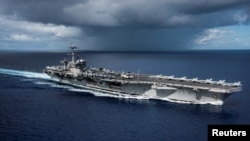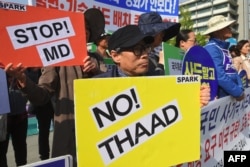North Korea test fired another missile, just one day after South Korea suspended the deployment of the U.S. Terminal High Altitude Area Defense (THAAD) anti-missile system.
The early morning launch occurred Thursday from the coastal city of Wonsan.
“Multiple projectiles that appear to be short-range, land-to-ship cruise missiles” were fired and flew about 200 kilometers before landing in the Sea of Japan or East Sea as it is called in Korea, according to South Korea’s Office of Joint Chiefs of Staff (JCS).
Targeting enemy vessels
North Korean leader Kim Jong Un last month ordered his military to develop the missile capability to precisely target enemy vessels at sea, according to North Korean state media.
During the first week of June, two U.S. aircraft carrier strike groups, the USS Carl Vinson and the USS Ronald Reagan, conducted military exercises in international waters between the Korean Peninsula and Japan.
The South Korean JCS said Thursday’s test was a direct response to the recent U.S. naval exercises.
“It was to show off the capability of various types of missiles and is an armed protest to show off its precise strike capability against enemy warships regarding the (recent) joint naval training of the U.S. carriers, or to secure an advantage in U.S. and North Korea or inter-Korean relations,” said JCS Chief of Public Affairs Roh Jae-Cheon.
The JCS also noted that North Korea’s test of low-altitude cruise missiles is not a violation of United Nations Security Council sanctions, which specifically prohibit high-altitude ballistic missile and nuclear weapons development.
Japanese Chief Cabinet Secretary Yoshihide Suga also said this cruise missile test did not warrant a response by the United Nations.
“The government has dealt with actions of North Korea based on responses of the international community, however, we don’t think this (North Korea’s missile launch this time) is something we need to protest against,” he said.
He also confirmed that the North Korean missiles did not reach his country’s exclusive economic zone that extends 370 kilometers from the coast.
THAAD on hold
Thursday’s launch is the fourth missile test by North Korea since South Korean President Moon Jae-in took office May 10, pledging to reduce tensions with Pyongyang through dialogue and engagement. His conservative predecessor, former President Park Geun-hye, was impeached for her alleged ties to a multi-million dollar corruption scandal.
President Moon convened his first meeting of the National Security Council Thursday where he ordered heightened military readiness to respond to any North Korean provocation.
“President Moon condemned (North Korea’s provocation by saying that) what North Korea will gain from this provocation is international isolation and economic difficulties and it will lose the opportunity for development,” said Park Soo-hyun, the spokesman of the presidential office after the NSC meeting.
The Moon administration Wednesday suspended the further development of THAAD until an environmental survey required by law has been completed. A presidential aide was reported to have said that the survey could take up to two years.
THAAD uses six mobile launchers and 48 interceptor missiles to target long-range ballistic missiles using high-resolution radar and infrared seeking technology. Two of the launchers were installed in March.
During the campaign, Moon called for a full review of the THAAD agreement before authorizing deployment.
U.S. President Donald Trump also raised concerns about the agreement when he demanded $1 billion for the American weapons system in April. Officials in both Washington and Seoul subsequently clarified the U.S. would bear the cost of THAAD system’s deployment and South Korea would provide the land and supporting facilities.
Undermining the U.S. alliance
Washington considers the advanced anti-missile battery critical for defense against North Korea’s growing nuclear and ballistic missile capabilities.
However China adamantly opposes the THAAD regional deployment that could potentially give the U.S. the means to counter its missile capabilities as well.
And many residents living near the deployment site have raised concerns over the possible negative health effects of the system’s powerful radar, and over the increased danger of North Korea targeting their region if hostiles break out.
Last week, the South Korean Defense Ministry approved the delivery of four remaining launchers without informing the presidential office. The president suspended a deputy defense minster for his role in bypassing the executive oversight function. Kang Kyung-hwa, Moon’s Foreign Minister designate, also called for the National Assembly to debate this national security matter.
On Thursday, the Defense Ministry declined to comment on the status of THAAD because of an internal investigation under way.
In the National Assembly Thursday, conservative Rep. Lee Cheol-woo with the opposition Liberty Korea Party said delaying THAAD is “neglecting the country’s duty,” while fellow party member Rep. Chung Woo-taik accused the Moon government of undermining the U.S. alliance, “while taking no measures whatsoever against North Korea’s missile launches.”
The South Korean presidential spokesman also said Thursday that Moon will reaffirm South Korea’s strong commitment to the U.S. alliance when he meets with Trump in Washington later this month.
Youmi Kim contributed to this report.












